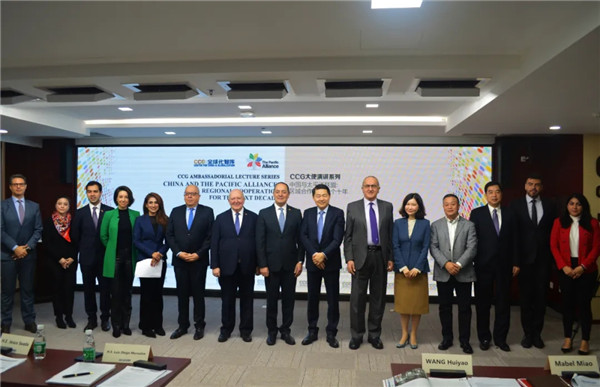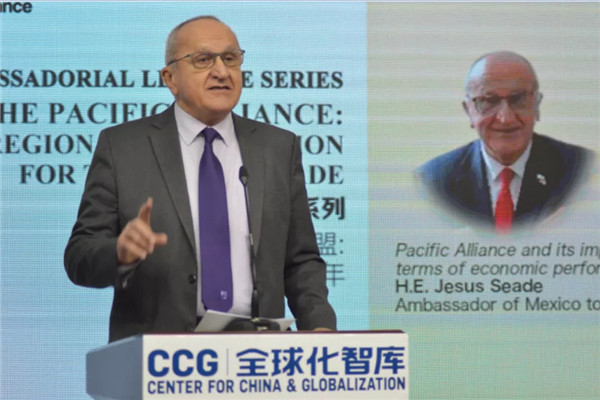Remarks of Amb. Jesus Seade at CCG’s Pacific Alliance Event
December 13 , 2021
This year marks the 10th anniversary of the creation of the Pacific Alliance. On Dec 13, CCG hosted public lecture series featuring the Pacific Alliance ambassadors – H.E. Luis Diego Monsalve, Ambassador of Colombia to China, H.E. Jesus Seade, Ambassador of Mexico to China, H.E. Luis Quesada, Ambassador of Peru to China and H.E. Luis Schmidt, Ambassador of Chile to China, on the future development of PA and prospects of China-PA cooperation.
The Pacific Alliance (PA) is a regional trade bloc launched in 2011 that includes Chile, Colombia, Mexico, and Peru as well as 59 observer states. With a combined population of 230 million, a per capita GDP of USD19,000, the Alliance is now the 8th largest exporter in the world. China is a key trading partner of Latin America and the Caribbean (LAC) as China-LAC trade grew 26-fold over the last two decades and expected to more than double by 2035.
A special address was made by H.E.esus Seade,, Ambassador of Mexico to China.

It is a well-known fact that Asia-Pacific is one of the most important regions in terms of population, GDP and trade in the world. The region’s human, natural, economic, financial and commercial resources make it one of the most relevant. The size of its economies represents close to 60% of the world gross domestic product (GDP).There are several regional agreements in the Pacific Basin promoting cooperation, trade and investment. These include the Pacific Basin Economic Council (PBEC), the Pacific Economic Cooperation Council (PECC), and the Asia-Pacific Economic Cooperation forum (APEC), which now joins together 21 economies on three continents. There is also the Comprehensive and Progressive Agreement for Trans-Pacific Partnership (CPTPP), created in 2008, and the Regional Comprehensive Economic Partnership (RCEP), created in 2015. In this context the Pacific Alliance of Latin America, plays a very important role in the Asian Pacific region given its enormous potential for the countries directly involved, as well as for the many possibilities of cooperation it offers with the rest of the world.
Our four countries, Chile, Colombia, Mexico and Peru have a combined population of 230 million inhabitants, with an average per capita gross domestic product (GDP) of 19,000 USD. The Pacific Alliance represents 41% of the GDP of Latin America and the Caribbean, accounts for 59% of total trade in the region and receives 38% of the foreign direct investment (FDI) that flows into the area.
The four founding countries of the Pacific Alliance put together add up to be the eighth largest economy in the planet and the eighth major exporter, with exports of $627 billion USD.
It should be mentioned that the four participating countries are focused on trade and investment relations with the rest of the world. All four have trade agreements –separate– with the US, while Mexico has secured trade agreements with more than 50 countries. Chile, Colombia and Perú also have a trade strategy that links the with European, Asian, North American and Latin American trade partners, in this regard, Chile and Peru have a bilateral FTA with China. Thus, the Pacific Alliance has the potential to leverage the members’ existing trade and investment experiences and project them to the world, as a conglomerate of nations with cultural, economic, political, and social affinities.
There is a Chinese proverb that says “let us bring our heads together for the benefit of all.” This regional integration alliance seeks to do just that: to create an innovative platform for shared production and competitiveness, increase the added value and sophistication of our products and exports.
In that way the four countries –which together represent 72% of all mid- and high-level technology exports in Latin America– work together in a coordinated manner to achieve shared goals.
The Pacific Alliance opens a door for member countries to export to new markets to which they previously had limited or no access, thus strengthening their supply chain to become more competitive on the global stage, with a particular focus on Asia, and specifically to China and its known growing domestic market boosted by its circular economy model.
This also opens the door for us to welcome additional flows of foreign direct investment aimed at keeping increasing the wellbeing of our people.
Topical News See more






